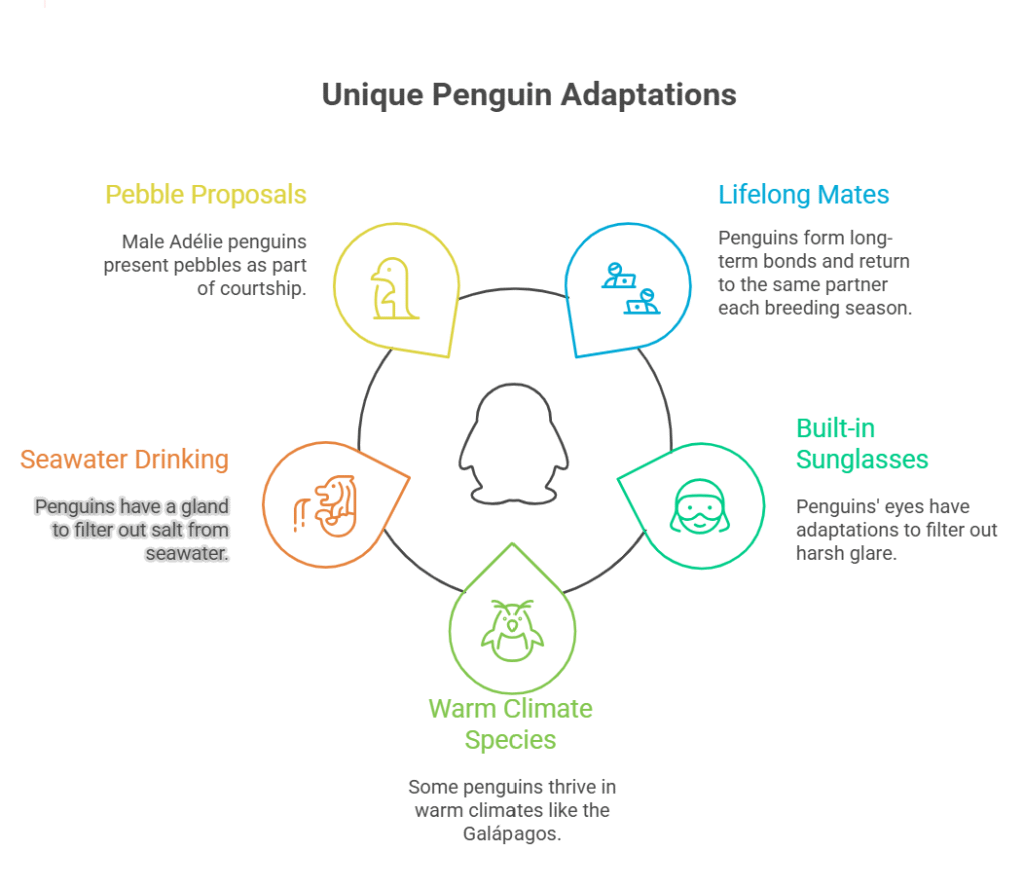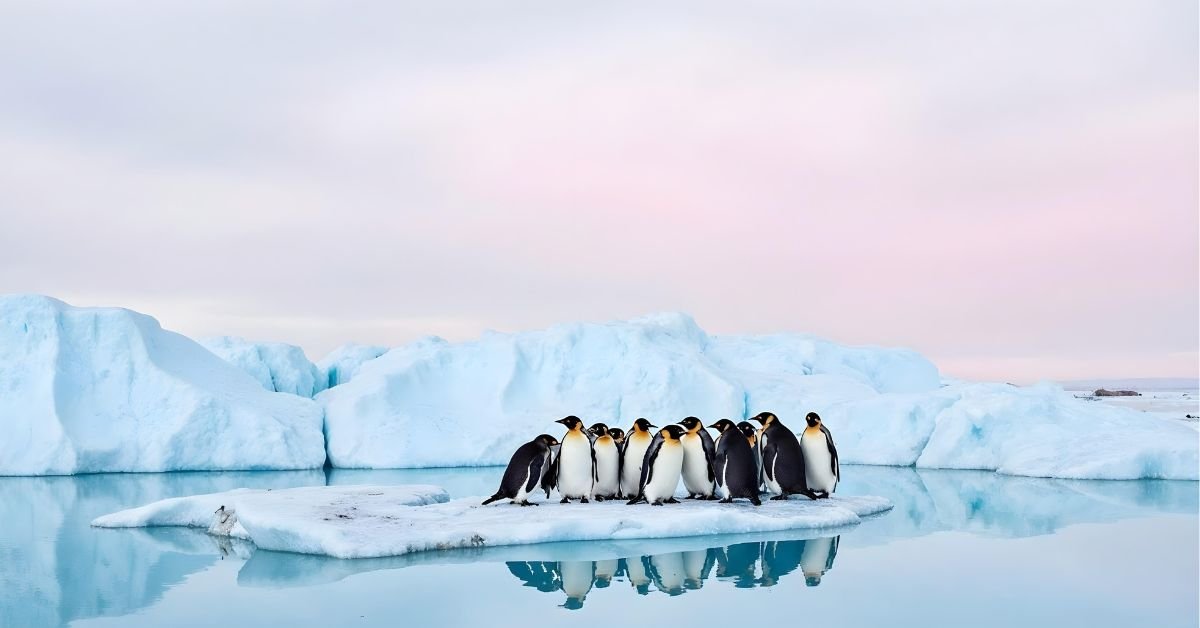Penguins aren’t just adorable—they’re evolutionary marvels. Unlike most birds, penguins have traded flight for swimming, becoming some of the most efficient underwater hunters on the planet. But what really sets them apart? It’s their diversity. From the towering Emperor penguin to the tiny Little Blue, each species has adapted to its own unique environment.
And no, penguins aren’t mammals. They’re birds—just ones that forgot how to fly and decided to become Olympic-level swimmers instead.
The Complete List of Penguin Breeds
Let’s break down the types of penguins you’ll find across the globe. There are 18 recognized species, each with its own story.
Emperor Penguin
The Emperor penguin is the largest of all penguin breeds, standing nearly 4 feet tall. These regal birds are famous for their epic journeys across the Antarctic ice, braving temperatures as low as -60°C. They’re the only penguins that breed during the harsh Antarctic winter, huddling together for warmth.
Fun fact: Emperor penguins can dive deeper than any other bird—over 500 meters!
King Penguin
Slightly smaller than the Emperor, King penguins are known for their vibrant orange patches on the head and neck. They breed on sub-Antarctic islands and are often mistaken for their larger cousins.
Adélie Penguin
Adélies are the classic “cartoon” penguin—black back, white belly, and a white ring around the eye. They’re feisty, social, and love to slide on their bellies across the ice.
Chinstrap Penguin
Named for the thin black line under their chin, Chinstrap penguins look like they’re always smiling. They’re among the most numerous penguin breeds, with millions living on Antarctic and sub-Antarctic islands.
Gentoo Penguin
Gentoos are easy to spot thanks to their bright orange beaks and the white “headband” across their heads. They’re the fastest underwater swimmers among penguins, reaching speeds up to 36 km/h.
Little Blue Penguin (Fairy Penguin)
Meet the world’s smallest penguin! Little Blues stand just 13 inches tall and are found along the coasts of Australia and New Zealand. Their slate-blue feathers make them unique among penguin breeds.
African Penguin
Also called the “Jackass penguin” for their donkey-like bray, African penguins live on the rocky shores of southern Africa. They’re the only penguin species found on the continent.
Magellanic Penguin
Named after explorer Ferdinand Magellan, these penguins breed along the coasts of Argentina, Chile, and the Falkland Islands. They’re known for their distinctive black bands across the chest.
Humboldt Penguin
Native to the coasts of Peru and Chile, Humboldt penguins are closely related to the Magellanic. They’re adapted to warmer climates and are often seen basking on rocky beaches.
Galápagos Penguin
The only penguin species found north of the equator, Galápagos penguins have adapted to the tropical climate of the Galápagos Islands. They’re among the rarest penguins, with fewer than 2,000 individuals left.
Royal Penguin
Royal penguins breed exclusively on Macquarie Island. They’re closely related to the Macaroni penguin and are known for their striking yellow crests.
Macaroni Penguin
If you’ve ever wondered about the penguin with yellow hair, this is it! Macaroni penguins sport wild, spiky yellow-orange feathers above their eyes. They’re one of the most numerous penguin breeds, with millions living in the sub-Antarctic.
Rockhopper Penguin
Rockhoppers are small, feisty, and famous for their punk-rock yellow crests. They hop from rock to rock (hence the name) and are found on islands in the southern Atlantic and Indian Oceans.
Erect-crested Penguin
These rare penguins have stiff, upright yellow crests and breed on remote New Zealand islands. They’re among the least studied penguin breeds.
Snares Penguin
Named after the Snares Islands of New Zealand, these penguins have thick yellow eyebrows and a robust build. They’re known for their loud calls and aggressive nesting behavior.
Fiordland Penguin
Also called the Fiordland crested penguin, this species is found in the rainforests of New Zealand’s South Island. Their thick yellow eyebrow stripes make them easy to spot.
Yellow-eyed Penguin
One of the world’s rarest penguins, the Yellow-eyed penguin is native to New Zealand. Their pale yellow eyes and headband set them apart from other breeds.
Northern Rockhopper Penguin
Similar to the Southern Rockhopper, but with longer crest feathers and a more limited range. They’re found on islands in the South Atlantic and Indian Oceans.
Are Penguins Mammals? Busting the Myth
It’s a question that pops up all the time: Are penguins mammals? The answer is a resounding no. Penguins are birds, through and through. They lay eggs, have feathers, and are warm-blooded. What confuses people is their upright posture and the way they care for their young—traits often associated with mammals.
But here’s the kicker: penguins are more closely related to albatrosses than to any mammal. Their unique adaptations, like dense waterproof feathers and solid bones for diving, make them one of the most fascinating bird families on Earth.
Interesting Facts About Penguins You Probably Didn’t Know
Penguins are full of surprises. Here are some interesting facts about penguins that might just blow your mind:
- Penguins mate for life. Many species form long-term bonds and return to the same partner each breeding season.
- They have built-in sunglasses. Penguins’ eyes have special adaptations to filter out the harsh glare of the sun on snow and water.
- Not all penguins live in the cold. Species like the Galápagos and African penguins thrive in warm climates.
- Penguins can drink seawater. They have a special gland that filters out salt, allowing them to stay hydrated even in the ocean.
- Some penguins “propose” with pebbles. Male Adélie penguins present pebbles to females as part of their courtship ritual.
One penguin fan once tweeted, “I wish I could be as chill as a penguin sliding on ice—no worries, just vibes.” Honestly, who wouldn’t want that kind of energy?

Penguin With Yellow Hair: Meet the Crested Penguins
If you’ve ever seen a photo of a penguin with wild yellow feathers sticking out like a rockstar, you’ve spotted a crested penguin. The most famous is the Macaroni penguin, but several other breeds sport similar “hairstyles,” including the Rockhopper, Erect-crested, and Snares penguins.
These yellow crests aren’t just for show—they play a role in attracting mates and signaling social status. In the penguin world, style really does matter!
Penguin Breeds: How They Adapt to Their Environments
Each penguin breed has evolved to survive in its own unique habitat. Emperor and Adélie penguins are built for the brutal cold of Antarctica, with thick layers of blubber and dense feathers. African and Galápagos penguins, on the other hand, have adapted to warmer climates, with less insulation and more efficient cooling systems.
Some penguins, like the Rockhopper, have developed strong legs and claws for climbing rocky cliffs, while others, like the Little Blue, are expert burrowers.
Real-Life Penguin Encounters: A User’s Story
“I visited Boulders Beach in South Africa and watched African penguins waddle right past my feet. They were so curious and unafraid, just living their best lives. It was magical to see them up close and realize how unique each penguin breed really is.”
Experiences like this remind us that penguins aren’t just distant wildlife—they’re part of our world, and they need our protection.
Conservation: The Risks Facing Penguin Breeds
Sadly, many types of penguins are at risk. Climate change, overfishing, and habitat destruction threaten their survival. Species like the Galápagos and Yellow-eyed penguins are critically endangered, with populations declining every year.
But there’s hope. Conservation efforts, like protected breeding areas and sustainable fishing practices, are making a difference. By learning about penguins and supporting conservation, we can help ensure these incredible birds thrive for generations to come.
Pros and Cons of Penguin Adaptations
Pros:
- Exceptional swimmers and divers
- Highly social and cooperative
- Adapted to a wide range of climates
Cons:
- Vulnerable to climate change and human activity
- Limited ability to escape predators on land
- Some species have very specific habitat needs
Features and Usability: Penguins in 2025
In 2025, penguins continue to captivate scientists and nature lovers alike. Advances in tracking technology have given us new insights into their migration patterns, breeding habits, and even their personalities. Zoos and aquariums worldwide are improving their habitats to better mimic the wild, offering educational programs that inspire the next generation of conservationists.
FAQs
Q. How many types of penguins are there?
A. There are 18 recognized species of penguins, each with unique features and habitats
Q. Are penguins mammals or birds?
A. Penguins are birds, not mammals. They lay eggs, have feathers, and are warm-blooded.
Q. Which penguin has yellow hair?
A. The Macaroni penguin is the most famous for its yellow crest, but Rockhopper, Erect-crested, and Snares penguins also have yellow “hair.”
Q. What are some interesting facts about penguins?
A. Penguins can drink seawater, mate for life, and some even “propose” with pebbles. Not all penguins live in cold climates—some thrive in the tropics!
Final Thoughts
Understanding the types of penguins isn’t just about trivia—it’s about appreciating the diversity of life on our planet. Each penguin breed tells a story of adaptation, survival, and resilience. Whether you’re a wildlife enthusiast, a parent teaching your kids, or just someone who loves cute animals, there’s always more to discover.
CLICK HERE FOR MORE BLOG POSTS
There’s a certain weight in the words John Authers writes—not just because of what he knows, but how he shares it. His voice doesn’t just echo facts; it builds meaning. In a world overwhelmed by rushed opinions and robotic summaries, John’s writing feels… different. It feels lived-in, thoughtful, and deeply human.
Readers don’t turn to John for headlines—they come for context. They come for that rare blend of clarity, insight, and emotional depth that turns financial journalism into something closer to storytelling. His reflections on markets, geopolitics, or human behavior aren’t just readable—they’re relatable.
What sets John apart isn’t just his experience (though he has plenty of it). It’s his ability to pause, reflect, and explain the why behind the what. He writes like someone who’s been in the room where it happens—but never forgets the reader who hasn’t.
In 2025, when AI churns out articles in milliseconds, John Authers still writes like a human—and that, more than anything, is what makes his work worth reading.











